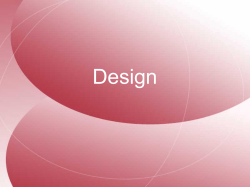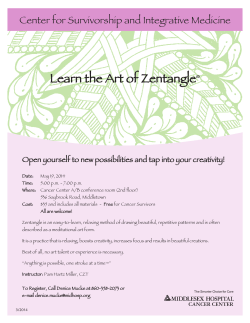
Thinking Skills and Personal Capabilities Unit 4 Encouraging Creativity
Thinking Skills and Personal Capabilities Unit 4 Encouraging Creativity © PMB 2007 Learning Intention • Be aware of how to encourage creativity across the Areas of Learning © PMB 2007 Activity 1 Current Practice • How do you encourage creativity in your classroom? © PMB 2007 How Can We Encourage Creativity? CLIMATE CULTURE CREATIVITY From; de A’Echevarria and Patience (Teaching Thinking & Creativity, Autumn 2005) © PMB 2007 How Can We Encourage Creativity? CLIMATE • • • • • From; de A’Echevarria and Patience (Teaching Thinking & Creativity, Autumn 2005) • Set open-ended and challenging tasks. Value all pupils’ contributions. Encourage new ideas and approaches. Encourage open communication. Challenge assumptions and stereotypes. Have fun! © PMB 2007 Climate and the Learning Charter Sample Charter It’s alright to: • • • • • • • Ask questions Try out new things Make mistakes Disagree Say how you feel Challenge statements Have fun when you learn © PMB 2007 How Can We Encourage Creativity? CLIMATE CULTURE • Language • Questions • Tools From; de A’Echevarria and Patience (Teaching Thinking & Creativity, Autumn 2005) © PMB 2007 Thinking Tool ‘The Ideas Filter’ Take all ideas Be uncritical Take risks Analyse ideas Judge ideas Question ideas ‘Give me all your ideas on…’ –Focus on Quantity– ‘Give me your best ideas on…’ –Focus on Quality– Best ideas © PMB 2007 How Can We Encourage Creativity? CLIMATE CULTURE • • • • CREATIVITY Imagining Generating Inventing Taking risks From; de A’Echevarria and Patience (Teaching Thinking & Creativity, Autumn 2005) © PMB 2007 The ICEDIP Model • • • • • • Inspiration Clarification Evaluation Distillation Incubation Perspiration ICEDIP Model created by Geoff Petty • There is no correct order to the process. • Each stage has its own mind-set. • All Areas of Learning can contribute to aspects of the creative process. • ‘Non-creative’ Areas of Learning or subjects can explicitly teach dispositions. • Not all stages will apply in every Area of Learning/subject. © PMB 2007 ICEDIP Mind-Sets INSPIRATION Deeply engrossed, fearless, free Researching and generating a large number of ideas. Being uninhibited, spontaneous, experimental and intuitive. If most of the ideas are workable, you did not take enough risks! CLARIFICATION Clear-minded, unhurried, questioning Clarifying the purpose and keeping a sense of direction. Focusing on how the finished work will look. Clarification is a process, not an event! It is done at frequent intervals. EVALUATION Self-critical, positive, willing to learn Considering how the work can be improved. Building on strengths, identifying weaknesses and viewing them as opportunities for improvement. Not seeing criticism as a threat. DISTILLATION Strategic, reflective Deciding what ideas to work on. Selecting best ideas or combining them into even better ones. Thinking about where the ideas can take you. INCUBATION Unhurried, trusting, flexible Leaving the work alone for a while, pondering it occasionally (keeping it on the surface of your mind), giving the subconscious time to work on it PERSPIRATION Enthusiastic, positive, persistent Generating a number of drafts, separated with clarification and evaluation phases. Creative people often do not accept a first draft, but go over and over a piece until it is to their liking. © PMB 2007 Discussion Point Which mind-sets could you develop to encourage creativity in your subject/classroom? © PMB 2007 Closing Points What pupils say would help them to be more creative: • Collaboration and sharing ideas helps. • Give us more open tasks; ‘don’t tell us exactly what to do.’ • Give us ‘free’ time during the day to be creative and to express ourselves. • Give us more choice. • Give us confidence; help us ‘do things for ourselves.’ • Don’t give us too much help. • There shouldn’t be a ‘right and wrong answer.’ © PMB 2007
© Copyright 2025













